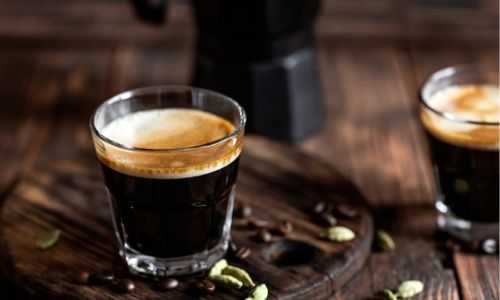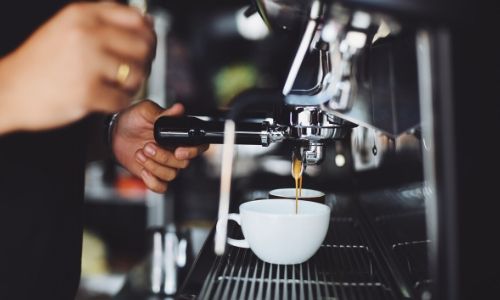Any aspiring barista is going to run into some espresso issues in their career. Whether you're trying to perfect your technique to become a professional, or you're simply an average Joe looking to make the best espresso, these things will haunt you.
So, let's take a look at the most common espresso issues, and how to fix them.
Keep in mind these are not all the troubles that might arise when brewing espresso, but simply the most common.
Also note that the issues noted bellow usually come in pairs or threes and are interconnected.
For example an overly strong espresso may come with too much crema and a very hard coffee puck, jam-packed with too much ground coffee.
Read through these carefully, to fully understand what may be affecting your espresso.
Table of Contents
Brew issues
Often we don't notice there's something wrong with the shot until we actually see the shot. Where a skilled barista might notice a shot will come out too weak by simply listening to the machine pull, you may not be that skilled just yet.
So let's get talk about how espresso can go wrong, starting with over and under dosing.
Espresso is too weak/watery
An espresso that's too weak is usually a sign that the water to coffee grounds ratio is too high.
The ideal ratio is a 1:2, meaning for every 10 grams of ground coffee you should end up with about 20 ml of liquid coffee. Some folks may like it 1:2.5 and some may find 1:1.5 is better for them.
In any case, a standard espresso isn't meant to have a 1:5 coffee to water ratio.
So check your portafilter, and see if it's too empty. If it is, after brewing the coffee you'll end up with a slushy coffee puck, instead of an compact thick disk.
If there isn't much slush, check the grind size.
Espresso needs very fine ground coffee. The exact stopping point when grinding will vary from machine to machine and the individual filter plates it uses.
But if you use ground coffee that's medium, you'll end up with weak espresso.
Aside from tasting weak, you'll notice the coffee is watery and has barely any crema as well.
Adjust the grind size a little smaller and keep testing until you find what works.
If none of the above applies, there is one last possible issue, which is brew temperature.
You see, the ideal water temp when brewing espresso is 93 C/200 F. This means that in most cases you will need to allow your machine to thoroughly heat through before pulling your first shot.
It can take anywhere from 5 to 30 minutes, depending on how large your machine is and what it uses to heat up.
You can speed up the process by pulling a blank shot (no coffee, just water) and thus pulling hot water through all the machine, heating all the elements a little faster.
So in short, if your machine isn't hot enough this means the water won't be hot enough, resulting in an espresso shot that's underextracted.
This means that even if you use a good ratio and the puck is still solid, the coffee will be weak. The cream will also be weak and disappear quickly.
And finally, you may get a weak espresso if the coffee you're using is very, very stale.
Recommended post: How many bars for espresso ?
Espresso is too strong
The reverse of what we've just discussed, an espresso that's way too strong.
You'll notice your espresso's too strong if it's overly bitter and just plain hard to swallow. It'll also have a higher percentage of solid mass in it than regular espresso.
One possible cause is using a ratio too small, such a 1:1 coffee to water in some cases. Unless you're pulling a ristretto or corto, this ratio will not be very pleasant.
Try and use less coffee, reducing by two grams each time, until you get to the right ratio.
If you're wondering about the correct amount of coffee per shot, it's usually around 20 gr. Not all portafilters are able to hold 20 grams of ground coffee, even tamped, so experiment with your own and see what fits.
Another reason for strong espresso might be coffee that's ground too fine. That's right, you can grind it too coarse or too fine, and you'll never know until you try it.
If using coffee that's too fine, the water will extract too much solid substance from the grounds. It may also back up your machine, if your grounds are extra fine and tamped way too hard (more on that later).
This all depends on how small the filter holes are in your portafilter, and this may vary from machine to machine.
Another explanation for overly strong espresso can be an overheated machine. Yes, you have to wait for it to warm up, but it can also get too hot.
If you've been brewing for quite some time now and each shot gets progressively stronger, it might be the water's too hot. This leads to overextraction, even if the ratio was correct.
Espresso is too bitter or sour
Usually a sign of overly strong espresso, see troubleshooting above. If none of the above apply, there is one last thing that may be the cause.
All espresso machines require thorough cleanup after a long, hard day of pulling shots. Especially in very busy coffee shops that don't allow them to get much rest (overheating them).
Cleaning your espresso machine top to bottom will make sure everything's in top order.
If you're an aspiring barista and this is your home machine we're discussing, there probably isn't a high volume of shots coming from your machine per day.
Which may cause you to think there isn't much wrong with the machine, doesn't need much cleaning since it's not heavily used.
Very wrong, and here is why. Each time a shot is pulled, the coffee oils in the grounds get released and stick onto the equipment, like portafilter, grouphead, channel.
If your espresso machine's also got a built-in grinder, that too may have some built-up coffee oils.
Cleaning the machine regularly will ensure those oils don't end up becoming rancid and thus imparting a sour/acrid flavor to your coffee.
If it's not coffee oils, it might be the water tank. This I know from experience, as I grew up with a manual espresso machine. Over time it started getting a sort of sour taste and the water tank smelled a little musky.
The water tank is the first to fill up with residue from impure water. This can and will mess with the overall flavor of your coffee.
There are cleaning solutions available for the water tank, and I strongly suggest you use such treatments every 3 months or so, aside from regular weekly deep cleans.
Finally, the heating element may have some built up gunk on it, especially limescale. This happens over time and you can give it a quick rinse with a dedicated solution every couple of months, to make sure it won't affect your machine.
Crema issues
If your espresso is fine (the liquid) but the crema seems a little off, there may be some adjustments you can make.
Keep in mind that sometimes it's not the machine's fault or yours, you may just need to change the coffee beans.
Spotted/tiger crema, the ideal version
Let's talk about this first. There seems to be this idea that spotted crema is the best. It apparently has something to do with aberrations within the coffee bean that are supposed to result in better tasting espresso.
If you don't know what tiger/spotted crema is, it's simply crema that has tiny darker streaks/spots throughout its layers. As opposed to smooth singe color, or a gradient.
Getting that crema is difficult, and kind of a rare feat.
Don't beat yourself up over not achieving it, there's no real point to it since it doesn't improve things noticeably.
Too much crema
If you're getting too much crema from your espresso, then congrats, you're one of the lucky few who have this problem.
The most common problem is actually the reverse, where crema simply doesn't come through and leaves you wanting.
Too much crema is usually a sign of your coffee blend containing too much Robusta. This may be uncommon for American espresso, where Arabica is king.
But you may find that other countries (or mixes imported from other countries) contain a percentage of Robusta.
Another possibility is if you've used too much ground coffee in the portafilter, leading to an overly hard coffee puck as well.
Too little crema/disappearing
The lack of crema seems to be the most common problem there is.
One possible explanation is stale coffee, as discussed before. Stale coffee has released most of its CO2 (so it has degassed), and that's a key element in building good crema.
No gas, no crema. You'll only get a small amount, with very few bubbles and those might disappear quickly.
Another reason may be water temperature (again). Either too hot or too cold, but most commonly too cold. Allow your machine to reach peak temperature before brewing.
Coffee grounds issues
If it's not the espresso and it's not the crema, you may be noticing that the coffee grounds have an issue and you don't know what's causing it.
For those who don't have a keen eye for detail (like for crema) or don't have a very well developed palate yet, mechanical issues like whether the coffee puck looks alright after brewing will definitely be obvious.
So let's discuss these, as you can also use them in conjunction with the other issues to really narrow down the problems.
Shot channeling
Let's tackle shot channeling first. This happens when the espresso's been tamped too hard to one side, or it hasn't been tamped enough.
This results in weak spots in the coffee puck, meaning that water will find it easier to pass through those specific places and not through all of the portafilter.
This leads to overextraction of some parts of the coffee, while others may end up completely dry.
What you can do is attempt to tamp the puck level, and try not to tap it on the side when done, since this will shift everything to the side.
Or, if your tamping isn't strong enough try and apply more pressure. Ideally you should work with something around 20 lbs/9 kg. If you don't know how that feels in your arm, use a scale and press on it until you get the hang of it.
Do not use a kitchen scale as that may not reach up to 20 lbs/9 kg.
Another possible explanation of channeling may be trouble in the grouphead itself.
Sometimes bits of ground coffee may get lodged inside tiny holes and may block water from coming out evenly. Check your grouphead and see if it's stuck in some parts.
Yet another possibility is if you've just rinsed the portafilter but haven't really dried it before adding more coffee. This means the water from the grophead will find those wet spots and will travel much faster in those areas.
Coffee puck too wet/slushy
If your coffee grounds look like a hot mess, then they might be too coarse or they weren't tamped enough.
This leads to lots of space where the water can fill in and create a sort of soup in the portafilter.
Another possibility is that you've used too little coffee grounds. They expand when in contact with the hot water, and ideally they should take up the headspace left between the coffee and grouphead filter.
If you've used too little coffee, there will be too much spare room for the coffee and it'll go everywhere.
Yet another possibility is using coffee that's too finely ground, and it will not really yield a shot. In this case you'll usually notice something's wrong and turn the machine off before it backs itself up.
There you'll notice the coffee's too mixed with the water and resembles mud more than anything. If your portafilter's filter is blocked this can be even worse.
Coffee puck too hard
If the coffee puck is too hard, there's pretty much only one explanation. You've used too much coffee and it all condensed into one coffee brick that's really difficult to get out.
Often this results in overly bitter espresso and an absurd amount of crema.
Try and dial down the coffee by two grams and keep experimenting.
Conclusion
Your espresso shots reflect your barista skills, true. But sometimes it's not you, it's the machine.
And when it is you, you'll know just what to do, thanks to this nifty post on how to fix the most common espresso issues.
I hope you found your issue here, and that the fixes did the trick for you.
If you want to know more about coffee or tea, feel free to check the related articles below. Who knows what else you might find ?










